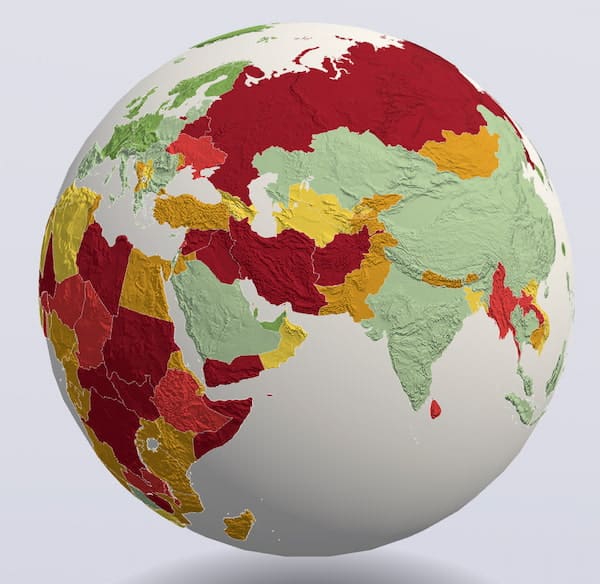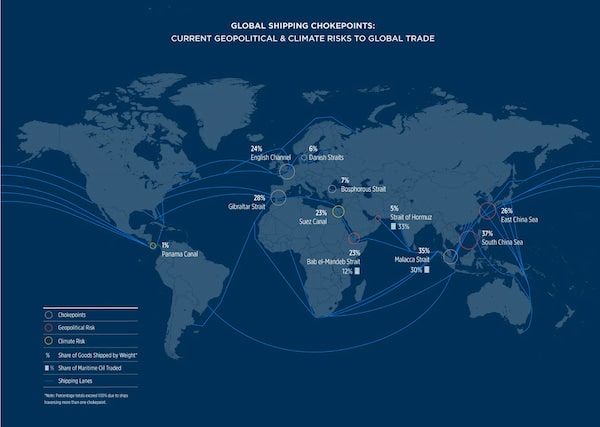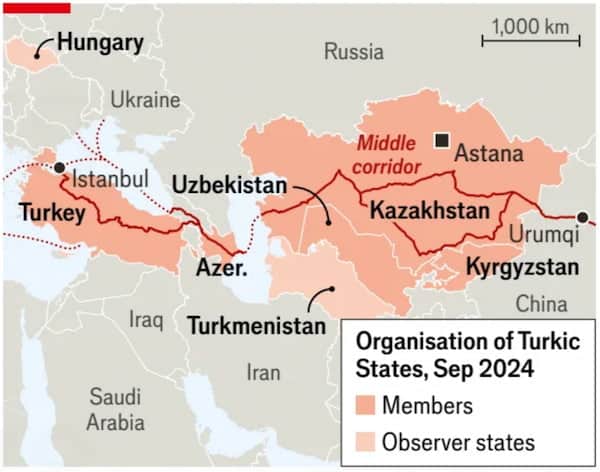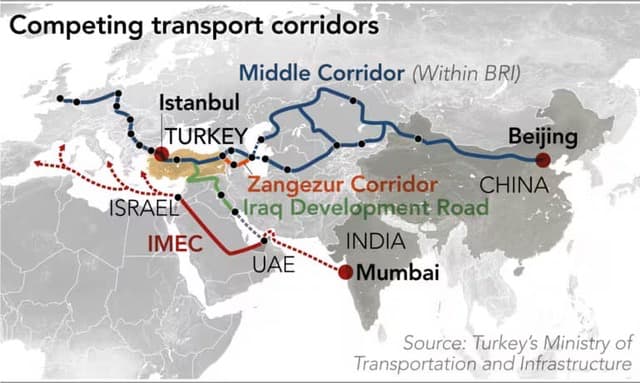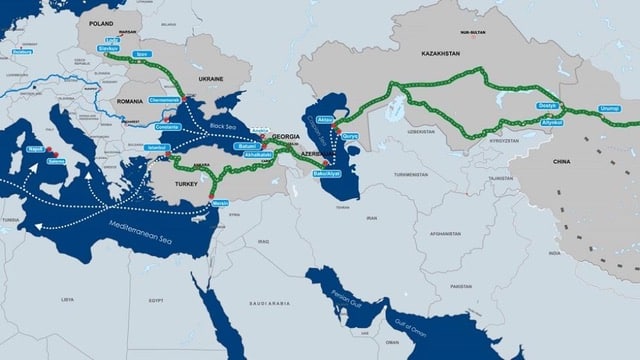The Land Based Silky Road Between China and Europe Through Central Asia Has Gained Momentum in the Last 5-10 Years Under the Name Middle Corridor. There is significant potential, with investments from the EU among others. However, the route is sensitive to unrest within and between countries. This is the fifth and final post in the series on logistical hubs.
Historically, the Silk Road Was an Engine of Economic Development
For over a thousand years, the network of trade routes along the approximately 8,000 km-long Silk Road from China through Central Asia to Europe was the most important corridor for global trade. The caravans also provided an economic foundation for the cities along the route.
Sea routes around Africa took nearly as much time but only became viable from the mid-18th century, when China allowed Western powers to access the port of Guangzhou (Canton).
However, in the early 20th century, the emerging global powers from the world wars closed the borders of the Central Asian states they controlled. Border security blocked the exchange of goods, and many countries along the ancient Silk Road fell into deep recessions that lasted for nearly a century. This made these countries—and China—keenly aware of the value of hosting transport corridors. Infrastructure is a prerequisite for economic development.
BRI Revived the Historical Silk Road
This recognition was a driving factor behind the world’s largest foreign loan initiative, China’s Belt and Road Initiative (BRI)launched in 2013, which focused specifically on infrastructure investments. Xi Jinping unveiled the BRI at a regional summit in Kazakhstan.
However, the BRI was more of a vision than a concrete plan. China wanted the countries involved to determine the corridors themselves. Yet, many of these nations have competing interests. As a result, plans for a new Silk Road have developed along two parallel tracks: a northern corridor through Russia to Moscow, and the Middle Corridor, as described below.
The northern corridor was, for a long time, the most developed. Since February 2022, however, international funding has dried up, and the project has slowed. In contrast, the Middle Corridor has accelerated since then.
The Middle Corridor Bypasses Russia
The Middle Corridor runs from China via Kazakhstan, the Caspian Sea, Azerbaijan, Georgia, the Black Sea, and on to Bulgaria and Turkey. In Kazakhstan, there are two routes: either the new Trans-Kazakhstan Railway or the older east-west route. Similarly, China is encouraging transit countries to explore opportunities for redundant routes.
The route allows goods to be shipped from China to Europe in under two weeks, despite requiring up to three transshipments and six reloading operations. By comparison, sea transport via the Malacca Strait and the Suez Canal takes two to three times as long.
It Could Offer Many Transit Countries New Geopolitical Opportunities
Geopolitically, the Middle Corridor includes Turkey, which is bypassed by IMEC (India-Middle East-Europe Economic Corridor). For Turkey, it is particularly significant that the corridor runs through countries that are members of the OTS, Organization of Turkic States. The OTS primarily serves as a counterweight to Russian dominance in Central Asia and is led by Turkey, which is also the largest economy among the members.
Turkey sees great potential in the Middle Corridor, which could reestablish Turkey as a global nexus for trade between Asia and Europe. To this end, Turkey has invested in port capacities, such as $1.2 billion in Izmir and $3.8 billion in Mersin. Turkey has further strengthened its nexus ambitions with the Southern Gas Corridor, running from Azerbaijan through Georgia, Turkey, Greece, and to Apulia in Italy (the heel of the boot).
...And Could Provide the EU Access to Critical Raw Materials
The Middle Corridor is also vital to Kazakhstan's ambition to increase its extraction and refinement of raw materials. Many of these materials are included in the EU's Critical Raw Materials List, including rare earth elements, beryllium, gallium, fluorite, tungsten, and uranium.
Since Russia's invasion in 2022, EU interest in the route has grown significantly. In 2022 alone, freight volumes along the corridor increased sixfold, and in 2023, transport volumes rose by 65%. Danish shipping giant Maersk is among the frequent users of the route. Both BRI and the EU have increased their investments, with the EU committing to over $10 billion to double the corridor's capacity by 2027. The route is expected to be fully developed by 2034.
The Middle Corridor’s current capacity is between 5 and 10 million tons of goods per year. Over the next 10-15 years, capacity is expected to increase to 15-20 million tons per year. However, this figure represents just 5-10% of the goods Asia currently ships to Europe via the Suez Canal. The corridor, therefore, cannot replace Suez and the Malacca Strait but can only provide limited relief.
However, the Corridor Is Sensitive to Latent Conflicts
Two primary factors limit the Middle Corridor’s long-term success: funding and security guarantees.
- Funding is currently the lesser of the two constraints. Countries like the UAE, China, India, and Saudi Arabia are actively lending to infrastructure projects, even those that do not directly benefit their economies. By contrast, the EU and the US’s PGII (Partnership for Global Infrastructure Investment) is more limited in scope.
- Security, however, is far less predictable. The land-based geography makes the projects vulnerable to tensions within and between participating countries. For instance, the CPEC (China-Pakistan Economic Corridor) project in Pakistan has been repeatedly affected by attacks on Chinese workers involved in the construction. Similar risks could also impact projects like IMEC (especially in Israel) and IDR (especially in Kurdistan).
... Particularly in the Caucasus and Central Asia
Key risk factors include:
- The potential for renewed conflict between Armenia and Azerbaijan. Armenia is supported by Iran, while Azerbaijan is supported by Russia. Both countries stand to lose geopolitical influence if the Middle Corridor succeeds.
- Escalation of Russia's hybrid warfare (black ops) in Georgia's northern provinces of Abkhazia and South Ossetia.
- Attempts by Turkmen or Azerbaijani minorities in Iran to seek independence once again.
The Middle Corridor Is Most Crucial for Enabling Trade in Critical Raw Materials
Global trade is fragmenting, a trend likely to continue over the next four years as Trump escalates trade wars with both Europe and Asia. For the EU, the primary risk lies in China retaliating with export bans on critical raw materials to Europe. This increases the EU's need for redundant supply lines, including from Kazakhstan.
The freight capacity of the Middle Corridor is too limited to serve as a truly redundant line for Europe's supply chains. However, it offers other valuable opportunities, particularly concerning critical raw materials.
Success, however, hinges on transit countries fostering deeper geopolitical cohesion to ensure the necessary transport security. The cost of failure is significant. For instance, in Pakistan, the lack of success in similar projects has led to a debt spiral, where debt servicing costs exceed expenditures on health and education.
For many years to come, the world's economies will thus remain interdependent and reliant on secure maritime trade routes.
See Also the Previous Four Blog Posts in the Series
